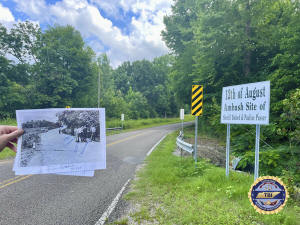Late crime-busting sheriff Buford Pusser inspired Hollywood.
Investigators say he killed his wife
[August 30, 2025]
By AUDREY McAVOY
A late Tennessee sheriff who inspired a Hollywood movie about a law
enforcement officer who took on organized crime killed his wife in 1967
and led people to believe she was murdered by his enemies, authorities
said Friday.
Authorities acknowledged that the finding will likely shock many who
grew up as Buford Pusser fans and watched 1973's “Walking Tall,” which
immortalized him as a tough but fair sheriff with zero tolerance for
crime. The movie was remade in 2004, and many officers joined law
enforcement because of his story, according to Mark Davidson, the
district attorney for Tennessee’s 25th judicial district.
There is enough evidence that if Pusser, the McNairy County sheriff who
died in a car crash seven years after his wife's death, were alive
today, prosecutors would present an indictment to a grand jury for the
killing of Pauline Mullins Pusser, Davidson said. Investigators also
uncovered signs that she suffered from domestic violence.
Prosecutors worked with the Tennessee Bureau of Investigation, which
began reexamining decades-old files on Pauline's death in 2022 as part
of its regular review of cold cases, agency director David Rausch said.
Agents found inconsistencies between Buford Pusser's version of events
and the physical evidence, received a tip about a potential murder
weapon and exhumed Pauline's body for an autopsy.
“This case is not about tearing down a legend. It is about giving
dignity and closure to Pauline and her family and ensuring that the
truth is not buried with time,” Davidson said in a news conference
streamed online. “The truth matters. Justice matters. Even 58 years
later. Pauline deserves both.”
Evidence does not back up sheriff's story
The case dates to Aug. 12, 1967. Buford Pusser got a call in the early
morning hours about a disturbance. He reported that his wife volunteered
to ride along with him as he responded. Buford Pusser said that shortly
after they passed New Hope Methodist Church, a car pulled up and fired
several times into the vehicle, killing Pauline and injuring the
sheriff. Buford Pusser spent 18 days in the hospital and required
several surgeries to recover. The case was built largely on his own
statement and closed quickly, Rausch said.

During the reexamination of the case, Dr. Michael Revelle, an emergency
medicine physical and medical examiner, studied postmortem photographs,
crime scene photographs, notes made by the medical examiner at the time
and Buford Pusser's statements. He concluded that Pauline was more
likely than not shot outside the car and then placed inside it.
[to top of second column]
|

This undated photo provided by the Tennessee Bureau of Investigation
on Friday, Aug. 29, 2025, shows the location in Guys, Tenn., where
then McNair County Sheriff Buford Pusser said his wife was killed on
Aug. 12, 1967. (TBI via AP)
 He found that cranial trauma
suffered by Pauline didn't match crime scene photographs of the
car's interior. Blood spatter on the hood outside the car
contradicted Buford Pusser's statements. The gunshot wound on his
cheek was in fact a close-contact wound and not one fired from long
range, as Buford Pusser described, and was likely self-inflicted,
Revelle concluded.
Pauline's autopsy revealed she had a broken nose
that had healed prior to her death. Davidson said statements from
people who were around at the time she died support the conclusion
that she was a victim of domestic violence.
Brother says investigation gave him closure
Pauline's younger brother, Griffon Mullins, said the investigation
gave him closure. He said in a recorded video played at the news
conference that their other sister died without knowing what
happened to Pauline and he is grateful he will die knowing.
“You would fall in love with her because she was a people person.
And of course, my family would always go to Pauline if they had an
issue or they needed some advice and she was always there for them,”
he said. “She was just a sweet person. I loved her with all my
heart.”
Mullins said he knew there was some trouble in Pauline's marriage,
but she wasn't one to talk about her problems. For that reason,
Mullins said he was “not totally shocked.”
Asked about the murder weapon and whether it matched autopsy
findings, Rausch recommended reading the case file for specifics.
The Tennessee Bureau of Investigation plans to make the entire file,
which exceeds 1,000 pages, available to the public by handing it
over to the University of Tennessee at Martin once it finishes with
redactions. The school will create an online, searchable database
for the case. Until then, members of the public can make
appointments to review it in person or can purchase a copy, said
university Chancellor Yancy Freeman Sr.
All contents © copyright 2025 Associated Press. All rights reserved |